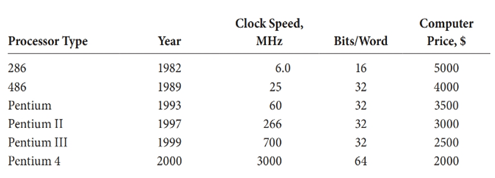
Concept explainers
Use a search engine such as Google to find information about Gordon E. Moore and Moore’s law, the famous law about technological advances that he proposed.
(a) What is Moore’s law? Give a brief description in your own words.
(b) Who is Gordon E. Moore? What was his position at the time he first proposed Moore’s law? What company did he later cofound? With whom did he cofound this company?
(c) In what field did Gordon E. Moore obtain his BS degree? At what university did he receive his BS degree? Where did he obtain his PhD degree? In what field was his PhD degree?
(d) What Nobel Prize-winning physicist gave Gordon E. Moore his first job opportunity?
(e) What was the number of the first microprocessor developed at Moore’s company and how many transistors did it have! When was it introduced!
(f) Read the article by Thomas Friedman on Moore’s law, and watch the video of his interview of Gordon E. Moore.9 In what year in what publication did Moore make his prediction? What was the most important lesson that Moore learned from his law? What stimulated his interest in science and engineering? What does Moore see as the biggest problem in science? How would you describe thestatus of Moore’s Law today!
(g) One important benchmark ofcomputational progress is the performance-to-price ratio (PPR) of computers.10 The PPR is the number of bits per word divided by the product of cycle time (1/clockspeed) and price. The original IBM PC (1981) with an 8bit word length, a 4.77 MHz clock, and a pricetag of $5000 came in with a PPR of ~7600. Computers based on other processors available in 2000 are listed in the following table.10 Calculate the PPR of each of these computers. Does Moore’s law hold forthe PPR? How did you come to your conclusion?

Want to see the full answer?
Check out a sample textbook solution
- 2. 200 LOD For an unknown compound with a molecular ion of 101 m/z: a. Use the molecular ion to propose at least two molecular formulas. (show your work) b. What is the DU for each of your possible formulas? (show your work) C. Solve the structure and assign each of the following spectra. 8 6 4 2 (ppm) 150 100 50 ō (ppm) 4000 3000 2000 1500 1000 500 HAVENUMBERI-11arrow_forwardComplete the spectroscopy with structurearrow_forwardComplete the spectroscopy with structurearrow_forward
 Chemistry: Principles and PracticeChemistryISBN:9780534420123Author:Daniel L. Reger, Scott R. Goode, David W. Ball, Edward MercerPublisher:Cengage Learning
Chemistry: Principles and PracticeChemistryISBN:9780534420123Author:Daniel L. Reger, Scott R. Goode, David W. Ball, Edward MercerPublisher:Cengage Learning Introductory Chemistry: An Active Learning Approa...ChemistryISBN:9781305079250Author:Mark S. Cracolice, Ed PetersPublisher:Cengage Learning
Introductory Chemistry: An Active Learning Approa...ChemistryISBN:9781305079250Author:Mark S. Cracolice, Ed PetersPublisher:Cengage Learning Introduction to General, Organic and BiochemistryChemistryISBN:9781285869759Author:Frederick A. Bettelheim, William H. Brown, Mary K. Campbell, Shawn O. Farrell, Omar TorresPublisher:Cengage Learning
Introduction to General, Organic and BiochemistryChemistryISBN:9781285869759Author:Frederick A. Bettelheim, William H. Brown, Mary K. Campbell, Shawn O. Farrell, Omar TorresPublisher:Cengage Learning Introductory Chemistry: A FoundationChemistryISBN:9781337399425Author:Steven S. Zumdahl, Donald J. DeCostePublisher:Cengage Learning
Introductory Chemistry: A FoundationChemistryISBN:9781337399425Author:Steven S. Zumdahl, Donald J. DeCostePublisher:Cengage Learning Chemistry & Chemical ReactivityChemistryISBN:9781337399074Author:John C. Kotz, Paul M. Treichel, John Townsend, David TreichelPublisher:Cengage Learning
Chemistry & Chemical ReactivityChemistryISBN:9781337399074Author:John C. Kotz, Paul M. Treichel, John Townsend, David TreichelPublisher:Cengage Learning





